CONTENTS
- Tamil Nadu and Kerala Should Discuss Dam Safety
- Press Freedom Index 2024 by Reporters Without Borders
Tamil Nadu and Kerala Should Discuss Dam Safety
Context:
The recent petition filed by Tamil Nadu in the Supreme Court of India regarding the ongoing Mullaperiyar dam dispute underscores the persistent issues with Kerala even a decade after the Court’s landmark decision permitting water storage up to 142 ft., up from the previously restricted 136 ft. Despite the formation of three committees aimed at ensuring robust disaster preparedness, a viable solution to the unresolved issues remains elusive.
Relevance:
- GS1- Water Resources
- GS2- Inter-State Relations
- GS3- Disaster Management, Infrastructure
Mains Question:
Discuss the origin of the Mullaperiyar Dam contention issue between Kerala and Tamil Nadu. How successful has judicial intervention been in this regard and what can be done to restore amicability in this context? (15 Marks, 250 Words).
The Mullaperiyar Dam:
- The Mullaperiyar Dam, a structure aged 126 years, is situated at the confluence of the Mullayar and Periyar rivers within Kerala’s Idukki district.
- Standing tall at a height of 53.66 meters and spanning a length of 365.85 meters, the dam is under the ownership, operation, and maintenance of Tamil Nadu.
- Tamil Nadu oversees its upkeep for various purposes, including irrigation, drinking water supply, and hydro-power generation.
- Turning to the Periyar River, it holds significant importance in Kerala’s geographical landscape. Spanning a length of 244 kilometers, the Periyar River holds the distinction of being the longest river in the state.
- It earns the moniker “Lifeline of Kerala” due to its status as one of the few perennial rivers in the region.
- Originating from the Sivagiri hills of the Western Ghats, located in Tamil Nadu, the river traverses through the Periyar National Park.
- Among its primary tributaries are the Muthirapuzha, Mullayar, Cheruthoni, and Perinjankutti rivers.
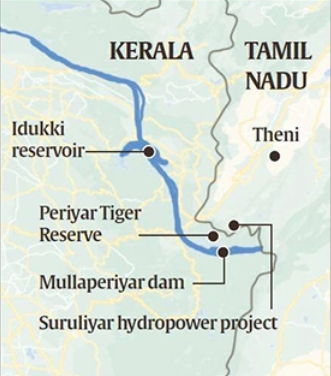
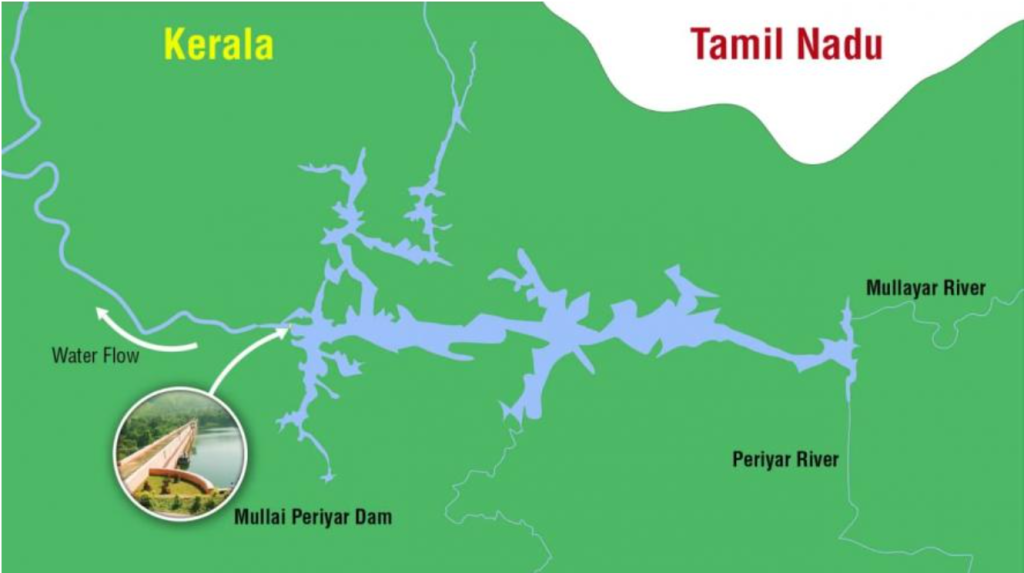
Background of the Dispute:
- In late 1979, amidst concerns over the structural integrity of the dam, a tripartite meeting chaired by K. C. Thomas, then Chairman of the Central Water Commission, concluded that the water level should be reduced to 136 feet from the full reservoir level of 152 feet.
- This decision aimed to enable Tamil Nadu to undertake necessary strengthening measures. Subsequently, in both 2006 and 2014, the Supreme Court ruled for an increase in the water level to 142 feet, a level Tamil Nadu adhered to even as recently as 2021.
- The 2014 judgment of the court also mandated the establishment of a supervisory committee and directed Tamil Nadu to complete any pending work. However, despite these directives, legal disputes persist, exacerbated by landslides in Kerala in recent years.
- In response, the Kerala government proposed the decommissioning of the existing dam and the construction of a new one.
- However, Tamil Nadu finds neither option entirely agreeable. Instead, it advocates for the completion of remaining strengthening works and the restoration of the water level to 152 feet.
Tamil Nadu’s Stance:
- Tamil Nadu emphasizes its dissatisfaction with the reconstituted Supervisory Committee, which, despite being empowered by the Dam Safety Act of 2021, has allegedly failed to compel Kerala and its agencies to authorize and facilitate essential dam strengthening measures and related works.
- Moreover, Tamil Nadu advocates for the expeditious completion of a comprehensive dam safety assessment within five years, by December 30, 2026, as mandated by the aforementioned law.
- Despite these efforts and legal mandates, the impasse between the two states persists, leaving the matter unresolved and the dam’s safety uncertain.
Judicial Intervention:
- Despite the lingering unresolved issues, judicial intervention has ushered in the implementation of a rule curve, a strategic tool utilized in decision-making to ensure the smooth operation of the dam’s shutters, particularly during periods of flooding, alongside the establishment of a gate operation schedule, despite Kerala’s reservations.
- Beyond the realm of dam-related disputes, contention arises over Kerala’s ambitious mega car parking project, entangled in legal proceedings. Tamil Nadu contests the Survey of India’s determination that the project site lies outside the leased area.
Way Forward:
- While Kerala remains steadfast in its prioritization of dam safety, proceeding cautiously, it is imperative for the two state governments, which historically share amicable relations, to reinitiate bilateral negotiations aimed at resolving pending issues while preserving their prerogative to seek legal redress.
- Recognizing that water and dam safety can be exploited to evoke emotional responses, proactive engagement from the political leadership in both states is essential in reconciling differences.
Conclusion:
Although judicial processes may be time-consuming, Tamil Nadu holds a more favorable track record with the Supreme Court compared to its counterpart concerning Mullaperiyar, evident in the judgments of 2006 and 2014. The proposed dialogues, even if they do not yield significant breakthroughs, present an opportunity for both states to gain a deeper understanding of each other’s perspectives, thereby precluding vested interests from polluting the atmosphere.
Press Freedom Index 2024 by Reporters Without Borders
Context:
In the 2024 edition of the press freedom index published by Reporters Without Borders, India holds the 159th position out of 180 nations surveyed. Although this marks a slight improvement compared to the previous year, India’s performance in terms of press freedom has persistently been subpar in recent times.
Relevance:
GS2-
- Fundamental Rights
- Indian Constitution
- Right to Information
- Transparency and Accountability
- Government Policies and Interventions
- E-Governance
Mains Question:
In the context of the recently released Press Freedom Index, 2024, examine the need of press freedom for a nation. Also analyse India’s performance in the index and suggest a strategy to ensure more freedom of the fourth pillar of democracy. (15 Marks, 250 Words).
More on the Index:
Press Freedom Worldwide:
- Bhutan witnessed a substantial decline, dropping from 80th place in 2019 to 147th in 2024, marking the most significant decrease. Hong Kong and Afghanistan followed suit in experiencing notable declines.
- Conversely, the Central African Republic, Timor-Leste, and Montenegro saw significant improvements in their press freedom rankings.
- Despite improvements in its score, Greece faces criticism for its ongoing failure to address issues such as wiretapping journalists by the intelligence service and the murder of veteran crime reporter Giorgos Karaivaz in 2021.
- In Israel, Al Jazeera ceased broadcasting on Sunday following the government’s shutdown, amid a longstanding feud with the Benjamin Netanyahu administration. Israel’s press freedom has diminished in 2024 compared to 2019, with its ranking dropping from 88 to 101.
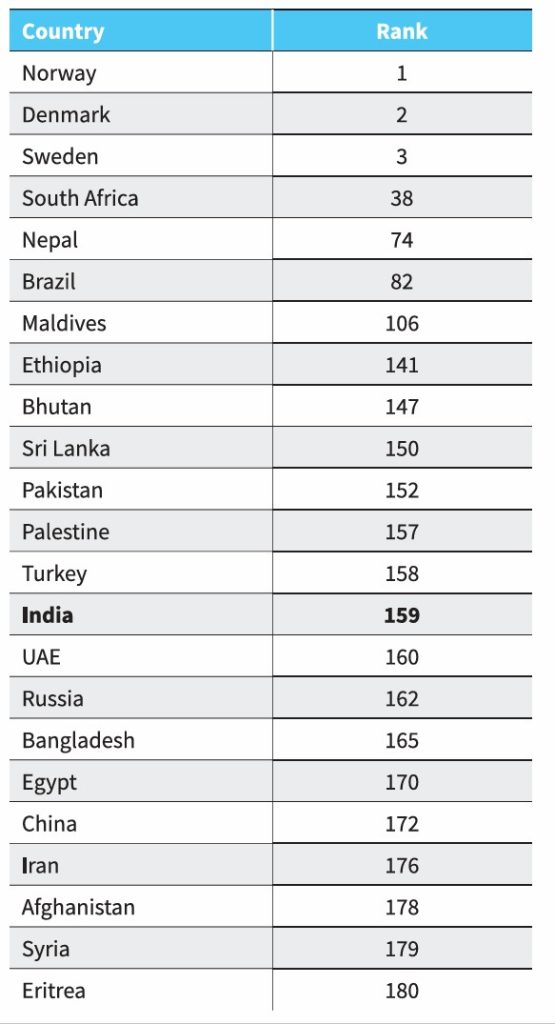
Press Freedom in India:
- India’s has shown a fluctuating ranking in the press freedom index over the years, consistently placing above 100 since 2003, indicating longstanding challenges in this regard.
- However, the erosion of press freedom has accelerated in recent years, with India hitting its lowest ranking of 161 out of 180 nations last year. In the 2024 index, India’s position improved marginally to 159th.
- According to the index, India’s current press freedom situation is on par with that of the occupied Palestinian territories, the United Arab Emirates (an absolute monarchy), Turkey (a democracy facing challenges), and Russia (an authoritarian regime).
- Once again, the Scandinavian nations, including Norway, Denmark, and Sweden, emerge as the top performers, while Eritrea, Syria, and Afghanistan rank the lowest.
- Among the BRICS countries, Brazil and South Africa fare better than India in terms of press freedom, while China and Russia are positioned lower.
- Among South Asian nations, with the exception of Bangladesh, all other countries rank higher than India in the latest index.
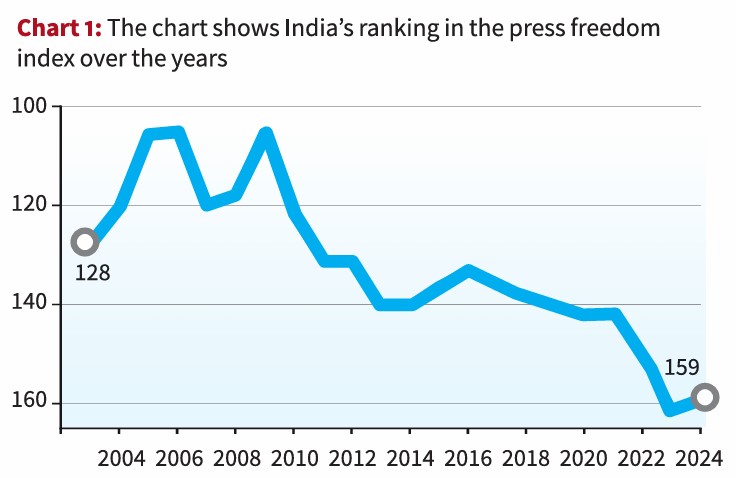
Necessity of Free Press:
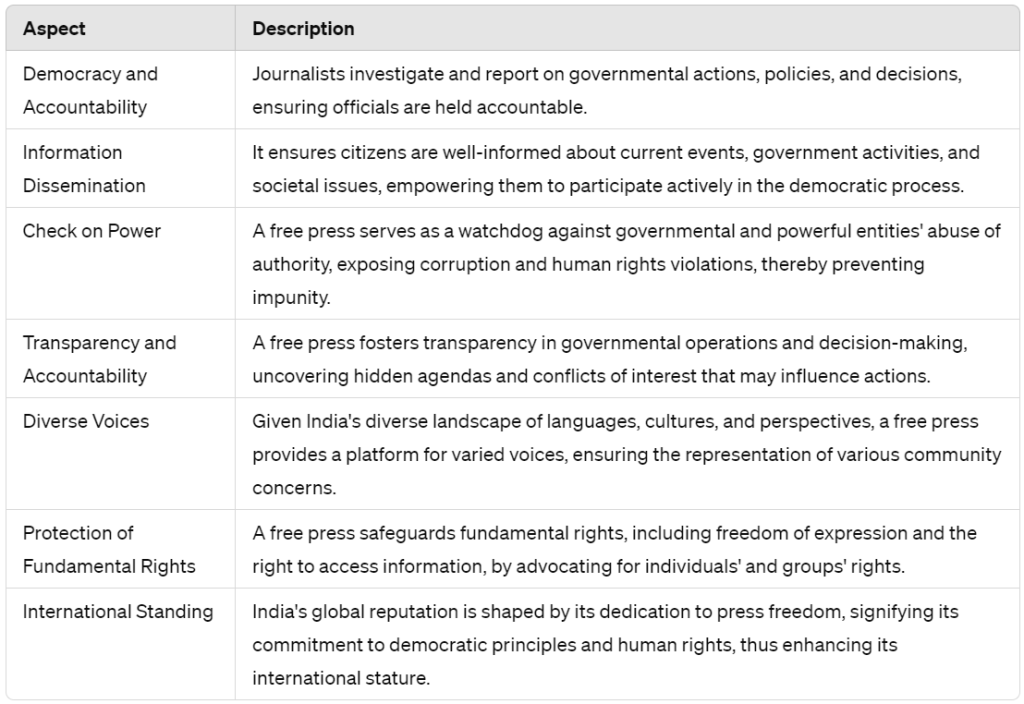
Institutions Responsible for Safeguarding Press Freedom in India:
- Press Council of India (PCI): Established under the Press Council Act, 1978, the Press Council of India is a statutory body tasked with overseeing and advocating for press freedom and ethical journalism standards.
- Ministry of Information and Broadcasting: The governmental Ministry of Information and Broadcasting formulates media-related policies and guidelines in India.
- News Broadcasters Association (NBA): Representing private television news and current affairs broadcasters, the NBA is a self-regulatory entity enforcing ethical standards for television news channels.
- Editors Guild of India: Comprising editors from prominent newspapers and news magazines, this voluntary association defends press freedom and addresses journalists’ rights and responsibilities.
- Legal System: India’s judiciary, including the Supreme Court, plays a crucial role in preserving press freedom by addressing violations, protecting journalists, and interpreting media-related laws.
- International Organizations: International bodies like Reporters Without Borders (RSF) and the Committee to Protect Journalists (CPJ) monitor press freedom violations in India and raise awareness globally about such infringements.
Way Forward:
Enhancing Legal Protections:
- Revise laws susceptible to misuse, such as defamation and sedition statutes, to safeguard press freedom.
- Ensure expeditious and equitable legal proceedings in cases involving press freedom infringements.
- Establishing Independent Regulatory Mechanisms:
- Institute autonomous media regulatory bodies comprising diverse societal representatives, immune to governmental and political influence.
Safeguarding Journalists and Whistleblowers:
- Enact and enforce legislation shielding journalists from harassment and violence, both online and offline.
- Develop mechanisms safeguarding whistleblowers disclosing information in the public interest.
Advancing Transparency:
- Enact robust freedom of information laws to foster governmental transparency and facilitate journalist access to official data.
- Enhance transparency in media ownership to counter media concentration and conflicts of interest.
Upholding Public Broadcasting Autonomy:
- Ensure autonomy of public broadcasting institutions from governmental control.
- Appoint impartial boards to oversee public broadcasters, securing nonpartisan funding.
Promoting Ethical Journalism:
- Encourage adherence to ethical codes emphasizing accuracy, fairness, and balanced reporting.
- Support professional development initiatives and training to uphold ethical standards among journalists.
Raising Public Awareness:
Educate the public about the pivotal role of a free and unbiased press in democratic societies.
Facilitating International Collaboration:
- Engage with global organizations like UNESCO and international press freedom advocates to advance press freedom agendas.
- Support initiatives like the UN Plan of Action on the Safety of Journalists to create secure environments for media practitioners.
Conclusion:
Addressing press freedom concerns in India demands collaborative efforts from diverse stakeholders committed to upholding the principles of an independent press in democratic settings. This multifaceted challenge necessitates ongoing vigilance and action to foster a robust and impartial media landscape in the nation.




